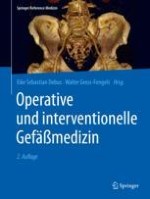Zusammenfassung
Juxta-, suprarenale und Abschnitt-IV-Aneurysmen sind im Vergleich zu abdominalen Aneurysmen selten. In einer großen autoptischen Serie von Patienten mit aortoiliakalen Aneurysmen zeigte sich die folgende relative Häufigkeit nach Lokalisation: abdominale Aorta allein 65 %; thorakale Aorta allein 19 %; abdominale Aorta plus Iliakalarterien 13 %; thorakoabdominale Aorta 2 %; und isolierte Iliakalarterien 1 % (Brunkwall et al. 1989). In einer vergleichenden Studie von 429 Patienten mit abdominalen und juxtarenalen Aortenaneurysmen präsentierten sich 86 % als infrarenal, und 14 % erstreckten sich bis an oder über die Nierenarterien (Ayari et al. 2001). Abschnitt-IV-Aneurysmen werden in 10–26 % der thorakoabdominalen Aortenaneurysmen beschrieben (Cambria 2000). Juxtarenale Aneurysmen sind etwa 3- bis 4-mal häufiger als suprarenale Aneurysmen (Nypaver et al. 1993). Populationsbasierte Studien schätzen die Inzidenz von klinisch offenkundigen abdominalen Aortenaneurysmen auf 21 pro 100.000 Personenjahre und von thorakalen Aortenaneurysmen auf 6 pro 100.000 Personenjahre (Bickerstaff et al. 1982). Epidemiologisch verhalten sich abdominale (inklusive juxta- und suprarenale) Aneurysmen und Abschnitt-IV-Aneurysmen unterschiedlich. Erstere kommen in einem Verhältnis Mann zu Frau von 2:1 bis 6:1, letztere in einem Verhältnis 1:1 bis 4:1 vor. Die Inzidenz von rupturierten abdominalen Aortenaneurysmen in der allgemeinen Bevölkerung wird mit 6,3 pro 100.000, diejenigen bei über 65-Jährigen mit 35,5 pro 100.000 angegeben (Heikkinen et al. 2002). Obwohl man annehmen müsste, dass die Zunahme der elektiven Versorgung die Anzahl der Rupturen senken sollte, konnte dieser Effekt bisher nicht eindeutig nachgewiesen werden (Heller et al. 2000). Auch konnte nicht klar aufgezeigt werden, dass juxta- und suprarenale Aneurysmen häufiger rupturieren würden, wie von einigen Autoren vermutet.











